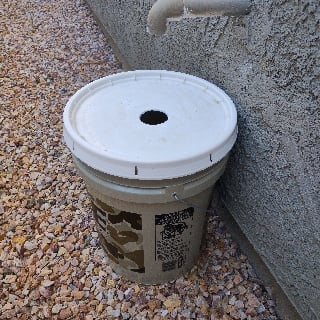Air conditioning condensate is an overlooked source of free “grey water.” But is it good for your plants? And can you collect enough of it in a hot dry climate to be worthwhile?

When I moved into my new Tucson home, I stuck a 5-gallon bucket under the AC condensate line. I was curious to see how much water I could collect.
I didn’t expect much but was pleasantly surprised at how quickly that bucket filled up. But before watering my plants with it, I needed to be sure it was safe. Here’s what I found out.
Is AC Condensate Water Safe?
When your AC system’s evaporator coil cools warm air that passes over it, condensation forms and ultimately drains out of your home. The result is a small stream of basically pure water that’s often compared to distilled water.
AC condensate is considered grey water and is safe for watering plants. It has no chlorine, fluoride, or other chemicals or minerals your plants may not like.
However, it’s not considered fit to drink since you don’t know the status of your pipes which could harbor bacteria or leach metals.
Other household sources of grey water include lightly used water
from bathroom sinks, showers, tubs, and washing machines.
Is AC Condensate Water Good for Plants?
So condensate water won’t harm your plants, but is it actually good for them?
No Minerals? No Problem
Plants need minerals and condensate water has none, so theoretically if you watered a plant with nothing but pure water and never fertilized it, that would be a problem. But in reality, that would never happen.
Watering with condensate is temporary. In the fall, you’ll stop using your AC and will go back to watering with tap water or rainwater.
If you’re still concerned, you can occasionally fertilize your plants to compensate for using condensate.
Flush Your Plants
If you’ve gardened in the southwest for a while, you may have heard that your plants, especially potted plants, accumulate “salts” (i.e., minerals) from our mineral-rich water and should be flushed occasionally.
But flushing them with the same tap water that created the problem is not ideal. Flushing with mineral-free condensate water is the perfect solution.
No Chlorine, No Fluoride
One of the key benefits of condensate water for plants is what it doesn’t have — namely, chlorine and fluoride.
Chlorine is added to our tap water to kill microorganisms, but it does not discriminate and also kills beneficial microorganisms that plants need to survive and flourish.
Some houseplants that specifically do not like chlorinated water include:
- bromeliads
- calatheas (Calathea)
- carnivorous plants
- dracaenas (Dracaena)
- prayer plants (Maranta)
- spider plants (Chlorophytum comosum)
- ti plants (Cordyline)
Fluoride naturally occurs in some areas and is intentionally added to tap water in others. There’s a long list of plants that don’t like fluoride including those mentioned above plus the following:
- lilies (Lilium spp.)
- never-never plant (Ctenanthe oppenheimiana)
- parlor palm (Chamaedorea elegans)
- peace lily (Spathiphyllum spp.)
- yuccas (Yucca spp.)
Not Sure if Fluoride is a Problem for Your Plants?
If you live in Arizona, only these communities currently fluoridate their water supply: Bisbee, Chandler, Gilbert, Glendale, Guadalupe, Mesa, Peoria, Phoenix, Tempe, and Yuma.
If you live in other states, you can find out if your water is fluoridated at the CDC’s interactive webpage My Water’s Fluoride.
How Much Water Can You Collect?
You might wonder if it’s worth your time to collect condensate. I wondered that, too.
On a typical low-humidity day, I collect 1-2 gallons. However, during the monsoon when the humidity is higher, I often collect 5 gallons or more. Depending on the size of your house and how hard your AC works, you may get more or less.
According to Brad Lancaster, a renowned authority on watering harvesting (and famous Tucsonan), a home air conditioner can generate up to 18 gallons of condensate per day when the humidity is high. Wow!
My Water Collection Setup
My water collection setup is embarrassingly simple, and I hope it could work for you. I use a 5-gallon camouflage bucket from Ace Hardware. I’m hoping my HOA doesn’t see it. (So far, so good.) 😉

For a year or so I was satisfied with this setup… until I found a bird in the bucket. 😢 Now I keep a lid on the bucket to keep critters out.

It was pretty easy to drill a hole in the lid and the placement of the hole wasn’t critical since the lid slopes downward, acting like a funnel. Alternatively, you can buy a 5-gallon bucket lid with a pre-drilled hole, spout, or opening cap.
Things to Watch Out For
Collecting condensate water is easy, but here’s a wrap-up of a few things to watch out for.
Drinking AC condensate water is not recommended since it could contain microbes or other contaminants.
Use the water you collect within a few days or adequately store (i.e., containers with lids). Buckets full of standing water can breed mosquitoes.
And don’t leave your bucket uncovered, since some critters might get in that won’t be able to get out.
Did you enjoy this article?
Sign up for our weekly newsletter
where you’ll find more great info on creating &
maintaining a beautiful, carefree desert landscape.
Author Bio
Deane Alban is the creator of Southwest Gardener. She is a science writer with a bachelor’s degree in botany from the University of South Florida. Gardening is her lifelong passion. She’s been gardening in Tucson for over 15 years.

Photo Credit
Davide Restivo from Aarau, Switzerland, CC BY-SA 2.0, Wikimedia Commons
